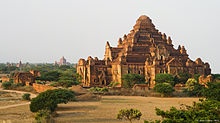Narathu
| Narathu နရသူ | |
|---|---|
 Dhammayangyi Temple built by Narathu | |
| King of Burma | |
| Reign | 1167 – c. February 1171 |
| Predecessor | Sithu I |
| Successor | Naratheinkha |
| Chief Minister | Ananda Thuriya |
| Born | 16 March 1118 Saturday, 9th waning of Late Tagu 479 ME Pagan (Bagan) |
| Died | c. February 1171 (aged 52) Pagan |
| Consort | Taung Pyinthe Myauk Pyinthe |
| Issue | Naratheinkha Narapatisithu |
| House | Pagan |
| Father | Sithu I |
| Mother | Daughter of Dhamakyin |
| Religion | Theravada Buddhism |
Narathu (Burmese: နရသူ, pronounced [nəɹəðù]; 1118–1171) was king of Pagan dynasty of Burma (Myanmar) from 1167 to 1171. Narahthu ascended the throne after murdering his father King Alaungsithu and his elder brother Min Shin Saw.[1] Narathu built the largest of all the Buddhist temples, the Dhammayangyi.[2] Nonetheless, his conduct greatly lowered the prestige of the dynasty, and he was deeply disfavored. The king was assassinated by the mercenaries sent by the chief of Pateikkaya in 1171.[3]
Early life
Narathu was a middle son of King Sithu I and Queen Yadanabon.[4] His mother was a daughter of Dhamma Kyin, a minister at King Kyansittha's court.[5] The chronicles do not agree on the dates regarding his life and reign. The table below lists the dates given by the four main chronicles.[6]
| Chronicles | Birth–Death | Age | Reign | Length of reign |
|---|---|---|---|---|
| Zatadawbon Yazawin | 1118–1170 | 52 | 1167–1170 | 3 |
| Maha Yazawin | 1114–1161 | 47 | 1158–1161 | 3 |
| Yazawin Thit | 1117–1171 | 54 | 1168–1171 | 3 |
| Hmannan Yazawin | 1123–1171 | 48 | 1167–1171 | 4 |
Narathu was a senior prince for much of his father's reign, whereas the king's eldest son Min Shin Saw was the heir apparent. However, Min Shin Saw had a major falling out with his father, and was sent to exile at Aung Pinle Lake (near present-day Mandalay).[7] With Min Shin Saw in exile, Narathu now positioned himself to take over the throne. He impressed his father with his management of day-to-day affairs of the kingdom. He soon became the de facto heir apparent at the court.[5]
Accession
In 1167, Sithu fell violently ill, and Narathu ordered the king moved to the Shwegugyi Temple, which Sithu had built in 1131. According to the chronicles, when the king woke up and realized that he had been moved out of the palace, he was furious. Narathu came into the room, and put a blanket over his bedridden father's head.[5]
He still needed to deal with Min Shin Saw, who had come down with an army to claim the throne. Narathu readily submitted, personally leading Min Shin Saw's coronation ceremony. After the ceremony, Min Shin Saw was poisoned while eating his first meal as king.[8]
Reign
Narathu's conduct lowered the prestige of the empire, and he was deeply unpopular. Burdened by his guilt, he shut himself in his palace.[3] To atone for the sins, he built the largest of all the Pagan temples, the Dhammayangyi.[2]
It is said that Narathu did not use water after using the toilet, and that the Pateikkaya queen did not let him come near her as a result. Narathu became angry, and killed a queen of his with his bare hands in a fit of range. The queen was a daughter of the chief of Pateikkaya, a tributary kingdom in the west in Bengal (near present-day Chin State).[9]
Death
Assassination by Pateikkaya
The chief of Pateikkaya, angered by Narathu's action, sent a group of eight assassins, disguised as Brahmin astrologers in 1171. The eight managed to gain an audience with the king while hiding their swords underneath their robes. They quickly slew the king. When the palace guards rushed in, they all committed suicide.[3]
Assassination by Polonnaruwa
According to a theory proposed by Gordon Luce, Narathu may have been killed by the assassins from Kingdom of Polonnaruwa in 1165.[10] Some inscriptions in Burma supported this theory,[11] along with the Culawamsa of Sri Lanka.
References
- ^ Coedès 1968: 167
- ^ a b Hall 1960: 22
- ^ a b c Htin Aung 1967: 50–51
- ^ Yazawin Thit Vol. 1 2012: 121, footnote 2
- ^ a b c Hmannan Vol. 1 2003: 304
- ^ Maha Yazawin Vol. 1 2006: 348
- ^ Hmannan Vol. 1 2003: 303
- ^ Htin Aung 1967: 49
- ^ Nyunt, Kyawt Maung Maung (2005). A Self-portrait of a Myanmar. Thwe Thwe Than Publishing House.
- ^ Than Tun 1964: 126–127
- ^ King Narathu, Archived
Bibliography
- Coedès, George (1968). Walter F. Vella (ed.). The Indianized States of Southeast Asia. trans.Susan Brown Cowing. University of Hawaii Press. ISBN 978-0-8248-0368-1.
- Hall, D.G.E. (1960). Burma (3rd ed.). Hutchinson University Library. ISBN 978-1-4067-3503-1.
- Htin Aung, Maung (1967). A History of Burma. New York and London: Cambridge University Press.
- Htin Aung, Maung (1970). Burmese History before 1287: A Defence of the Chronicles. Oxford: The Asoka Society.
- Kala, U (1724). Maha Yazawin (in Burmese). Vol. 1–3 (2006, 4th printing ed.). Yangon: Ya-Pyei Publishing.
- Royal Historians of Burma (c. 1680). U Hla Tin (Hla Thamein) (ed.). Zatadawbon Yazawin (1960 ed.). Historical Research Directorate of the Union of Burma.
- Royal Historical Commission of Burma (1832). Hmannan Yazawin (in Burmese). Vol. 1–3 (2003 ed.). Yangon: Ministry of Information, Myanmar.
